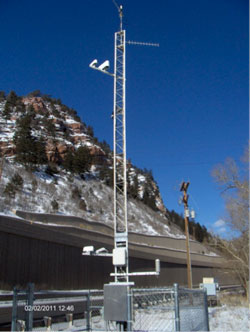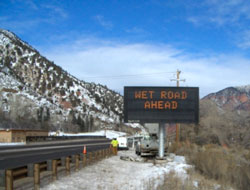Best Practices for Road Weather Management
Colorado DOT Variable Speed Management System
Colorado State Highway 82, in Snowmass Canyon (between Aspen, CO and Glenwood Springs, CO) is composed of an elevated southbound roadway that shades the northbound roadway during certain times of the day causing rapidly changing freezing conditions. The Colorado Department of Transportation (CDOT) installed the Variable Speed Management System which consists of a complete Road Weather Information System (RWIS), using newly developed non-intrusive pavement weather sensor technology. The pavement sensors monitor traction/friction conditions in the area that is shaded, and allow for alerts when conditions warrant. The system is capable of monitoring wet conditions, wet conditions with traction loss as freezing begins, and snow and ice conditions. The system wirelessly communicates to a single variable message sign (VMS) and a single variable speed sign (VSS) that are located nearly a mile in advance of this northbound section of highway in Snowmass Canyon (see Figures CO-3 and CO-4).
System Components: The system consists of the following major components:
- Variable Message Sign
- Road Weather Information System (RWIS), which consists of the
following:
- Remote Processor Unit
- Non-Intrusive Surface State Sensor
- Non-Intrusive Surface Temperature Sensor
- Air Temperature/Relative Humidity Sensor
- Precipitation Identifier and Visibility Sensor
- Ultrasonic Wind Sensor
- Pan-Tilt-Zoom Color Camera
- Relay Device Control
- Wireless Device Control
System Operations: The system provides continuous monitoring of atmospheric and pavement weather conditions to determine changing driving conditions that will impact the motorist and alert transportation managers of these changing conditions. The Non-Invasive pavement weather sensors are capable of monitoring changing traction values that will impact driving conditions for the motorist. They are also capable of alerting the motorist of these conditions by displaying messages on the variable message sign and potentially providing advisory speed limits as a result of these changing pavement conditions.
The system monitors current atmospheric conditions by monitoring when precipitation is occurring in the form of rain, freezing rain, or snow, with the ability to display rates and accumulations. The system is able to provide alerts to Colorado Department of Transportation (CDOT) operations of these changing atmospheric and pavement weather conditions allowing for remote access to conditions by computer and cell phone. The camera allows for live images of changing weather conditions at the site.
The system monitors traction level thresholds. When slippery thresholds for wet and icy thresholds are reached, activation of different messages such as “Wet Roads Ahead” or “Icy Roads Ahead” are produced by the RWIS processor. The “wireless device control,” utilizing spread spectrum radios, activates these different messages in the VMS that is located nearly a mile in advance of this stretch of highway. The “wireless device control” also is capable of providing different controls for different suggested speeds with the “variable speed sign.”
Transportation Outcome(s): The unique road topography of Colorado State Highway 82 caused shading and precipitation build-up on certain portions of the road at various times of the day, resulting in a large number of winter weather related accidents during the several years prior to the installation of this Intelligent Transportation System. The first winter of operation resulted in no winter weather related accidents in this section of highway in Snowmass Canyon.
Implementation Issues: Buried telephone was not readily available at the RWIS and VMS sites so a wireless cell phone modem was installed at the RWIS site to communicate to the RWIS site. Communication was also established from the RWIS site to the VMS site using a spread spectrum radio system as described previously. Even if there is a cell phone outage the RWIS can communicate to the VMS site.
The Variable Speed Limit Sign which was installed and operated with no issues, but was later removed at the request of CDOT Staff Traffic.
Contact(s):
- Mike Curtis, CDOT Region Traffic Engineer, 970-683-6277.
Reference(s):
- Jerry R. Waldman, Vaisala, Inc.
- Gary Eckley, Sturgeon Electric.
- Fred Ingham, Skyline Products, Inc.
Keywords: Intelligent Transportation System, atmospheric weather sensors, non-invasive pavement weather sensors, hazardous atmospheric weather, road weather traction conditions, and alert motorists alerts, variable message signs, variable speed signs.
previous | next
